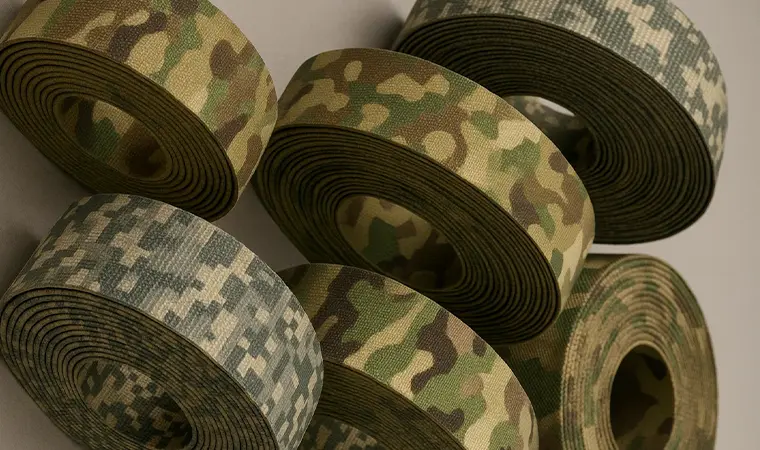For manufacturers of tactical, hunting, and outdoor gear, camouflage webbing is more than just a design choice—it's a critical performance component. The effectiveness of a pattern, its durability, and its ability to avoid detection can make or break a product's reputation. But not all camo webbing is created equal.
As a specialized webbing manufacturer, we field many questions from B2B clients about how to source the best camo webbing. This guide will walk you through the essential considerations, from printing technology and material selection to mission-critical performance factors like Infrared Reflectance (IRR).
How is Camouflage Webbing Made? A Look at Printing Technology
A common question we receive is, "how is camouflage webbing made?" Unlike solid-color webbing, which is typically solution-dyed, camo patterns are applied to the surface of a pre-woven, light-colored base webbing. The quality of the final product heavily depends on the printing method used.
The Industry Standard: Dye Sublimation Printing
Dye sublimation is the superior method for creating durable and vibrant camouflage patterns. The process involves printing the camo design onto special transfer paper with sublimation inks. This paper is then placed on the webbing and subjected to high heat and pressure. The heat turns the ink into a gas, which permeates the fibers of the webbing before solidifying. The result is a pattern that is permanently bonded into the material, not just sitting on top of it.
- Durability: The pattern is highly resistant to cracking, peeling, and fading because it's part of the webbing itself.
- Clarity: Allows for complex, high-resolution patterns like digital and multi-environment camos.
- Feel: The process doesn't alter the texture or "hand" of the webbing, keeping it flexible.
While dye sublimation is the gold standard, it's important to distinguish it from less durable methods like screen printing, which can wear off with abrasion. For a different approach to custom branding, you can also explore our guide on jacquard vs. printed webbing, which discusses woven-in designs.
Choosing the Right Base Material: Polyester vs. Nylon
The base webbing material is just as important as the printing method. The choice between polyester and nylon impacts both the printing quality and the final product's performance characteristics.
| Material | Printing & Performance | Best For |
|---|---|---|
| Polyester Webbing | Polyester is the ideal material for dye sublimation. Its fibers readily accept the sublimated ink, resulting in sharp, vibrant, and long-lasting patterns. It also boasts excellent UV resistance and low water absorption, preventing the webbing from sagging or stretching when wet. | Backpacks, MOLLE systems, pouches, and general-purpose outdoor and hunting gear where color stability is paramount. |
| Nylon Webbing | While nylon offers superior tensile strength and abrasion resistance, it is more challenging to print on using sublimation. It requires special pre-treatments to achieve good results. The main advantage is leveraging nylon's inherent toughness for high-stress applications. | Heavy-duty applications like gun slings or load-bearing straps on military and tactical gear where abrasion is a primary concern. |
Manufacturer's Note: For over 90% of camouflage webbing applications, polyester provides the best balance of print quality, durability, and all-weather performance. We typically recommend it unless a specific mil-spec calls for a printed nylon base.
Critical Performance Factors for Camo Webbing
For B2B buyers, evaluating camo webbing goes beyond the pattern. Three key performance metrics determine whether the webbing is suitable for professional-grade equipment.
1. Color Fastness: Resisting the Elements
A camouflage pattern that fades is a pattern that fails. Color fastness measures how well the webbing's colors resist fading or running when exposed to various conditions. For camo webbing, the most important factors are:
- Light Fastness: Resistance to fading from UV exposure (sunlight).
- Crocking (Rub) Fastness: Resistance to color transfer from rubbing against other surfaces.
- Wash Fastness: Resistance to fading after washing.
A reputable manufacturer should be able to provide data on these metrics. For a deeper dive, read our in-depth guide to color fastness.
2. Infrared Reflectance (IRR): The Key to Modern Concealment
For military and tactical applications, IRR is a non-negotiable feature. IRR compliant camouflage webbing is treated to reflect infrared light at a similar level to the surrounding natural environment (like foliage or soil). This prevents the gear from appearing as a bright, unnatural shape when viewed through night vision devices.
This is a highly specialized treatment applied during the manufacturing process. When sourcing for military contracts, always specify the need for IRR compliance. You can find this option in our range of Military Webbing.
3. Custom Patterns and Consistency
While popular patterns like MultiCam®, Woodland, and various digital camos are common, many brands seek a competitive edge with unique designs. As a custom camouflage pattern webbing manufacturer, we can work with your proprietary designs to create exclusive products.
Equally important is pattern consistency. Your production run needs webbing that matches from the first meter to the last. This requires stringent quality control, a topic we cover in our article on managing dye lot variation.
Conclusion: Building Gear on a Foundation of Performance
Effective camouflage webbing is a technical system. It's the result of combining the right printing technology (dye sublimation), the optimal base material (usually polyester), and critical performance treatments like IRR and high color fastness.
Choosing a supplier who understands these nuances is crucial. A cheap, poorly printed webbing can compromise the integrity and function of an otherwise well-made product, from a tactical belt to a high-end hunting backpack. As we detailed in our guide to military belts, the webbing is always the foundation.
If you're developing a product line that demands reliable, high-performance camouflage webbing, partner with an expert. Contact TMG Webbing today to discuss your requirements for custom patterns, IRR compliance, and certified materials. Let's build your gear on a foundation of strength and concealment.

